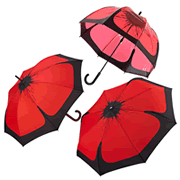Wellington Quarry — la Carrière Wellington, Arras

|
The Wellington Quarry - la Carrière Wellington was opened in 2008. It is an underground museum which has been carefully and sensitively created in a section of the many kilometres of tunnels dug by the British Army in the 1914-1918 war. The First World War tunnels connect with original tunnels and quarries dating back to the middle ages and Roman times underneath the city of Arras.
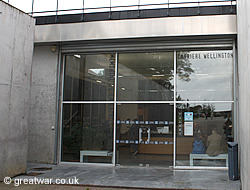
|
The museum is founded to the memory of thousands of men of the British Army and Dominion Forces who lived under the city during the Great War of 1914-1918. In particular work of the tunnelers of the New Zealand Division is commemorated. The New Zealand Tunneling Company was based in this part of the underground tunnel system during the build-up to the Allied offensive, the Battle of Arras 1917, which was launched in the early hours of 9 April 1917.
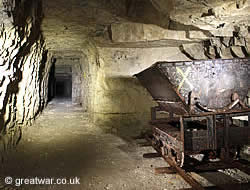
|
From the arrival of the British in the Arras sector in March 1916 New Zealand Tunneling Companies dug a network of tunnels in the ground underneath the Ronville and Saint-Saveur districts of Arras. They dug new tunnels and rooms and joined them up with the existing ancient tunnels and quarries or pits already under the city, quarried out hundreds of years before. The tunnels were fitted with running water and electricity supplies. Accommodation in the underground city was available for the soldiers to live and sleep in, and there was a large hospital for treating the wounded in a labyrinth of rooms with enough space to fit 700 beds and operating theatres.

|
The name for this particular quarry and tunnel system came about because names were needed to help the people underground find where they were. Signposted names and numbers were given to the tunnels and rooms underground. The New Zealanders based in this particular system named the place “Wellington“, after the capital city of New Zealand.
A message written by Lieutenant-General J A L Haldane, commanding the VI Corps during the Battle of Arras (9 April - 4 May 1917), is inscribed on the wall at the entrance to the museum. It reads:
“I wish to bring to the Army Commander's notice the excellent work done by the New Zealand Engineers Tunneling Company, during the past twelve months. First under Major Duigan and now under Captain Vickerman, the work of the Company has been excellent. Not only have the men worked extremely hard and well, but the excellent relations that have been maintained with the various divisions shows a first class organization.
I attach a copy of a report I have received from G.O.C. 3rd Division, which expresses the opinion held by the divisions in the line of the New Zealand Tunneling Company.”
Underground Guided Tour
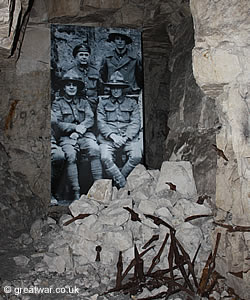
|
Visitors in groups of up to about 20 people are taken 20 metres down below ground level to the underground quarry and tunnels in a lift. The lift has glass walls and as the lift descends, visitors can see the chalk walls of the lift shaft.
Each person wears a headset with their chosen language. The guide takes the group on a tour through the tunnels lasting approximately 25 minutes.
The guide stops at set intervals to give a short explanation. In addition, the headsets automatically start at set places to give very clear descriptions for visitors; the commentary describes the difficult time experienced by the French and British soldiers and the local townspeople who lived underground at Arras throughout the war. The commentary gives a history of the tunnels and quarries dug into the chalk under the city, and it details the work carried out by the tunnelers together with the preparations they made for a surprise British attack starting the Battle of Arras 1917. Many hundreds of British infantry assembled in these tunnels before the launch of the Allied offensive at the Battle of Arras on 9 April 1917.
The guided visit to the tunnels shows a number of features of special interest which were found in these tunnels when they were discovered and excavated. These include mining trucks and bits of equipment, food containers such as glass bottles, tins and rum jars left in the tunnels. There are numerous example of drawings and “graffiti” on the walls by soldiers.
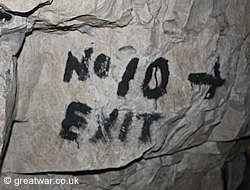
|
At the end of the guided tour the group passes Exit Number 10, one of the exits from the tunnels which the troops took to climb up to the Front Line positions and go into the attack at 5.30am (English time) on the morning of 9 April. Many hundreds of soldiers would never return.
On leaving the tunnels using the lift the group is invited into a small cinema to watch a short and moving film about the Battle of Arras 1917.
Reception & Shop
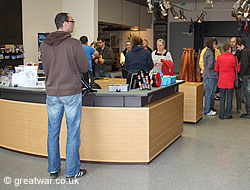
|
A small but well-stocked shop at the reception desk sells related books in English and French, postcards and souvenirs. Leaflets about visiting Arras and the surrounding area are also available.
Visitor Information
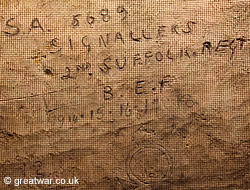
|
Opening Hours
- Open: Daily 10.00-12.30 hours and 13.30-18.00 hours
- Closed: 1 January, 8-26 January, 25 December 2018.
Admission charges
7 euros / Concessions 3.30 euros (most major credit cards are accepted). (Note: These were the 2017 rates. There may be an increase for 2018 rates.)
Guided Visit
A tour of the Wellington Quarry is conducted by a guide at all times. The last tour of the day departs one hour before closing time.
Group Visits & Group Reservations
Groups wishing to visit should contact the Arras Tourist Office in advance to discuss arrangements.
Email: (Arras Tourist Office) contact@explorearras.com
Access to the Underground Museum

|
There are no steps during the visit via the lift to the underground tunnels. The tunnels are dimly lit for their preservation. As visitors enter each section of the tunnel, the lights come on at that section and go out behind the group.
Visitors with any questions about access for anyone with limited walking ability should contact the museum by telephone or by email. English is spoken. The museum's website is managed as part of the Arras Tourist Office website.

|
The temperature underground is cool (11C) and it is recommended to wear warm clothing for the tour. Photography is allowed.
Toilets
There are toilet facilities near the reception desk for museum visitors.
Contact Details
Address: Rue Arthur Delétoille, 62000 ARRAS, France
Telephone: (Arras Tourist Office) +33 (0)3 21 51 26 95
Fax (Arras Tourist Office): +33 (0)3 21 71 07 34
Email: (Arras Tourist Office) contact@explorearras.com
Website: (Arras Tourist Office website) www.explorearras.com Carriere-wellington/Wellington Quarry
Wellington Quarry - la Carrière Wellington Location
Latitude N 50° 16' 50" ; Longitude E 2° 46' 57"
The Wellington Quarry museum is located on the Rue Arthur Delétoille in the south-east part of Arras. Rue Arthur Delétoille is a small road, turning off the D917 Avenue Ferrand Lobbedez, approximately 800 metres south of the road bridge over the railway line and next to (south of) the Leclerc supermarket car park. Turn off the D917 into Rue Arthur Delétoille, and the entrance to the Wellington Quarry is signposted in Rue Arthur Delétoille approximately 150 metres on the right. This entrance for vehicles is one way.
Vehicles exit from the car park onto the Rue du Temple, which runs parallel to Rue Arthur Delétoille.
Please note: The aerial mapping image may not be updated to show the museum entrance and site, built in 2008.
Parking
There is a free car park for cars and coaches during museum opening hours.
Related Topic
A section of preserved Allied and German trench line can be visited at the Memorial Park managed by the Canadian government.
Preserved Trenches at Vimy Memorial Park


